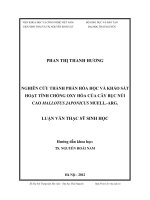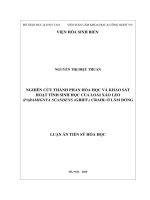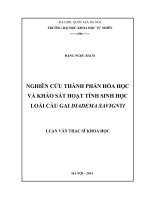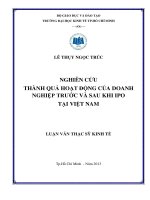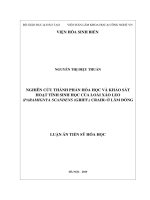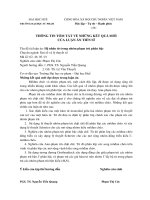Thông tin tóm tắt về những đóng góp mới của luận văn thạc sĩ: Nghiên cứu thành phần hóa học và khảo sát hoạt tính gây độc tế bào của các hợp chất phân lập từ vỏ cây Dà quánh (Ceriops decandra)
Bạn đang xem bản rút gọn của tài liệu. Xem và tải ngay bản đầy đủ của tài liệu tại đây (3.11 MB, 6 trang )
<span class='text_page_counter'>(1)</span><div class='page_container' data-page=1>
L E T T E R - S P E C T R A L A S S I G N M E N T
Structure elucidation of two new diterpenes from
Vietnamese mangrove
Ceriops decandra
Nguyen Van Thanh
1|
Kieu Thi Phuong Linh
1|
Pham Thanh Binh
1|
Nguyen Phuong Thao
1|
Nguyen The Cuong
2|
Tran Thi Bich Ha
6|
Nguyen Van Chien
3|
Nguyen Quoc Trung
4|
Vu Huy Thong
5|
Nguyen Xuan Cuong
1|
Nguyen Hoai Nam
1|
Chau Van Minh
11<sub>Department of Bioactive Natural Products, Institute of Marine Biochemistry, Vietnam Academy of Science and Technology, Hanoi, Vietnam</sub>
2<sub>Melinh Station for Biodiversity, Institute of Ecology and Biological Resourses, Vietnam Academy of Science and Technology, Hanoi, Vietnam</sub>
3<sub>Department of Corrosion and Protection of Metals, Institute for Tropical Technology, Vietnam Academy of Science and Technology, Hanoi, Vietnam</sub>
4<sub>Department of Chemistry and Catalytic Materials, Institute of Materials Science, Vietnam Academy of Science and Technology, Hanoi, Vietnam</sub>
5<sub>Department of Basic Science, University of Fire Fighting and Prevention, Hanoi, Vietnam</sub>
6<sub>Faculty of Quality Standards and Reference Substances, Institute of Drug Quality Control Ho Chi Minh city, Ho Chi Minh, Vietnam</sub>
Correspondence
Nguyen Van Thanh, Department of Bioactive Natural Products, Institute of Marine Biochemistry, Vietnam Academy of Science and Technology,
Hanoi, Vietnam.
Email: ,
Funding information
Vietnam Academy of Science and Technology, Grant/Award Number: TĐPCCC.04/18-20
1
|
I N T R O D U C T I O N
Ceriops decandra (Griff.) W.Theob. (Rhizophoraceae), a
true mangrove plant, occur in Africa, Australia, South
Asia, and many countries of Southest Asia [1]. The bark
of C. decandra is an Indian folk medicine used for the
treatment of diarrhea, amoebiasis, hemorrhage, and
malignant ulcers [2]. The leaf extract has been reported
to exhibite antinociceptive activity [3]. Previous
phyto-chemical investigations on this plant resulted in the
isola-tion of lupane- and ursane-type triterpenoids from the
leaf [4], beyerane-, pimarane-, kaurane-, and
abietane-type diterpenoids from the roots [1, 5–7], and
abietane-and podocarpane-type diterpenoids from the barks [2,
8]. In an ongoing search for bioactive natural products
from mangroves [9, 10], we report here the isolation,
structure elucidation, and cytotoxicity assay of two new
diterpenes, ceridecandrin A (1) and B (2), from
C.decandrastem barks. Their structures were elucidated
by analysis of HR-QTOF-MS and 1D and 2D NMR
spec-troscopic data. It should be noted that compound1is the
first example of a 8,15-epoxypimarane-type diterpenoid
possessing a 14,16-ether bridge, and compound 2 is the
second member of a rare class of 10,19-epoxyrosane-type
diterpenoid (Figure 1).
2
|
R E S U L T S A N D D I S C U S S I O N
Ceridecandrin A (1) was obtained as white, amorphous
powder. Its molecular formula was determined to be
C20H32O3 on the basis of 13C NMR data (Table 1) and
HR-QTOF-MS ion peaks at m/z 321.2416 [M + H]+
(calcd for C20H33O3+, 321.2424),m/z343.2244 [M + Na]+
(calcd for C20H32O3Na+, 343.2244), and m/z 338.2687
[M + NH4]+(calcd for C20H36O3N+, 338.2690), indicating
five index of hydrogen deficiency. The 13C NMR and
HSQC spectra disclosed 20 carbon signals, corresponding
to four methyls, seven sp3 methylenes (including one
oxymethylene at δC 74.2), five sp3 methines (consisting
three bearing oxygen atδC70.7, 84.1, and 85.1), and four
sp3quartenary carbons (one oxygenated atδC89.0). The
DOI: 10.1002/mrc.5091
</div>
<span class='text_page_counter'>(2)</span><div class='page_container' data-page=2>
presence of five oxygenated carbons and the absence of
any unsaturated carbon, in combination with the
molec-ular formula C20H32O3, suggested that compound1was a
pentacyclic diterpenoid with two ether linkages. The1H
NMR spectrum exhibited four singlet methyl signals at
δH0.86 (s, H-19),δH0.90 (s, H-20),δH0.91 (s, H-18), and
δH1.06 (s, H-17), three oxygenated methine protons atδH
3.61 (br s, H-14),δH4.01 (br s, H-15), and δH4.11 (br s,
F I G U R E 1 Structures of Compounds
1and 2
T A B L E 1 1
H (500 MHz) and13C NMR (125 MHz) data for1(in CDCl3) and2(in CD3OD)
Position
1 2
δC δH(Jin Hz) δC δH(Jin Hz)
1 40.5 β1.63 (1H, overlapped)
α0.85 (1H, overlapped)
31.2 β1.77 (1H, overlapped)
α1.69 (1H, overlapped)
2 18.5 β1.48 (1H, overlapped)
α1.37 (1H, overlapped)
29.8 β1.95 (1H, dddd, 4.5, 7.0, 14.0, 16.5)
α1.71 (1H, overlapped)
3 41.8 β1.41 (1H, overlapped)
α1.17 (1H, ddd, 3.5, 13.5, 13.5)
75.4 3.56 (1H, br d, 4.0)
4 32.6 - 49.0
-5 45.2 1.28 (1H, overlapped) 45.6 2.20 (1H, dd, 5.0, 14.0)
6 26.6 1.69 (2H, overlapped) 18.4 β1.47 (1H, overlapped)
α1.42 (1H, overlapped)
7 70.7 4.11 (1H, br s) 27.7 α1.62 (1H, overlapped)
β1.26 (1H, overlapped)
8 89.0 - 32.9 1.67 (1H, overlapped)
9 49.8 1.25 (1H, overlapped) 40.0
-10 36.4 - 91.2
-11 19.3 β1.75 (1H, dddd, 7.0, 14.0, 14.0, 14.0)
α1.44 (1H, overlapped)
32.4 α1.78 (1H, overlapped)
β1.25 (1H, overlapped)
12 31.2 β2.00 (1H, dddd, 1.5, 7.0, 14.0)
α1.59 (1H, overlapped)
33.6 β1.55 (1H, ddd, 3.5, 13.5, 14.0)
α1.24 (1H, overlapped)
13 46.3 - 37.1
-14 85.1 3.61 (1H, br s) 42.0 α1.27 (1H, overlapped)
β1.23 (1H, overlapped)
15 84.1 4.01 (1H, br s) 152.3 5.82 (1H, dd, 10.5, 17.5)
16 74.2 α3.93 (1H, dd, 1.0, 8.0)
β3.78 (1H, br d, 8.0)
109.3 α4.93 (1H, dd, 1.0, 17.5)
β4.87 (1H, overlapped)
17 18.4 1.06 (3H, s) 22.7 1.02 (3H, s)
18 33.5 0.91 (3H, s) 16.1 0.97 (3H, s)
19 22.2 0.86 (3H, s) 77.4 β3.68 (1H, d, 8.5)
α3.64 (1H, d, 8.5)
</div>
<span class='text_page_counter'>(3)</span><div class='page_container' data-page=3>
H-7), and a pair of oxymethylene protons atδH3.78 (br d,
J= 8.0 Hz, H-16β)/3.93 (dd,J= 1.0, 8.0 Hz, H-16α).
Careful interpretation of correlations observed in the
COSY and HMBC spectra revealed that the planar
struc-ture of 1 (Figure 2) was similar to that of 8,15R
-epoxypimaran-16-ol [7] andent-8,15R-epoxypimaran-16-ol
[11], except for the presence of an additional hydroxyl
group at C-7, and an ether bridge between C-14 and C-16
in 1. Indeed, the HMBC correlation from H-15 (δH4.01)
to C-8 (δC 89.0) established the 8,15-epoxy linkage. The
hydroxyl group was located at C-7 due to COSY
cross-peaks of H-5/H-6/H-7, as well as the HMBC correlations
from H-5 (δH 1.28) to C-7 (δC 70.7). The connection of
C-14 and C-16 through an oxygen atom was confirmed by
HMBC correlation from H-14 (δH3.61) to C-16 (δC74.2).
The relative configuration of1was determined by the
analysis of coupling constant and NOESY spectrum. The
small vicinal coupling constant of H-7 (δH4.11, br s) and
the large vicinal coupling constant of H-3α (δH 1.17,
J= 3.5, 13.5, 13.5 Hz) and H-11β(δH1.75, J= 7.0, 14.0,
14.0, 14.0 Hz) suggested the equatorial orientation of H-7
and the axial orientations of both H-3α and H-11β. The
NOESY correlations of H-3α/H3-18, H3-18/H-5,
H-5/H-1α, H-1α/H-2α, H-1α/H-9, H-9/H-11α, H-9/H-12α, H-9/
H-14, H-14/H3-17, H3-20/H-1β, H3-20/H-2β, H3
-20/H-11β, and H-2β/H319 confirmed the structure of pimarane
diterpenoid skeleton of1[5] andα-configuration of H-14
(Figure 3). Thetrans-fusion between the B and C rings of
pimarane scaffold, together with NOESY cross-peaks of
H-16β/H-7 and H-16α/H3-17, indicated that H-15 was
β-orientation. Thus, structure of 1 was determined as
8,15:14,16-diepoxy-7α-hydroxy-pimarane.
Ceridecandrin B (2) was isolated as white,
amor-phous powder. The molecular formula of 2, C20H32O2,
was deduced from the 13C NMR data, and [M + Cl]−
ion peaks at m/z 339.2071 and 341.2059 with a ratio of
3:1 (calcd for C20H32O2Cl−, 339.2096, and 341.2067) in
the HR-QTOF-MS, corresponding to five index of
hydrogen deficiency. The 13C NMR and HSQC spectra
revealed the presence of 20 carbons, including four
nonprotonated carbons (one bearing oxygen at δC
91.2), nine methylenes (one sp2carbon at δC 109.3 and
one oxygenated at δC 77.4), four methine (one sp2
car-bon at δC 152.3 and one oxymethine at δC 75.4), and
three methyls. The presence of two sp2 carbons and
three oxygenated carbons, along with the HR-MS data
analysis, indicated that 2 was a tetracyclic diterpenoid
with an ether bridge. The 1H NMR spectrum showed
signals for one monosubstituted double bond at δH
5.82 (dd, J = 10.5, 17.5 Hz, H-15), δH 4.87
(H-16β)/4.93 (dd, J = 1.0, 17.5 Hz, H-16α), one
oxymethine group at δH 3.56 (br d, J = 4.0 Hz, H-3),
one oxymethylene group at δH 3.64 (d, J = 8.5 Hz,
H-19α)/3.68 (d, J = 8.5 Hz, H-19β), and three singlet
methyls at δH 0.96 (s, H-20), δH 0.97 (s, H-18), and δH
1.02 (s, H-17). Detailed analysis of COSY and HMBC
correlations (Figure 2) revealed that the planar
struc-ture of 2 was closely related to that of euphomianol A
[12], a rosane-type diterpenoid with a 10,19-oxygen
bridge, except for the absence of a hydroxy group at
C-5 in 2. This was confirmed by the COSY cross-peaks
of H-5/H2-6/ H2-7/H-8/H2-14 and the HMBC
correla-tions from H2-19 (δH 3.64/3.68) to C-3 (δC 75.4), C-4
(δC 49.0), C-5 (δC 45.6), C-10 (δC 91.2), and C-18 (δC
16.1).
According to the coupling constant values between
H-3 and H-2β (J = 4.5 Hz), between H-2β and H-1α
(J = 14.0 Hz), and between H-12β and H-11α
(J= 13.5 Hz), H-3 was assigned as equatorial orientation,
and both H-2βand H-12βwere in axial orientation. The
NOESY correlations of H-3/H-2β, H-2β/H-19α, H-2β
/H-1β, H-19β/H-6β, H-6β/H3-20, and H3-20/H-12β revealed
that these protons were cofacial and they were in
β-configuration (Figure 3). By contrast, NOE cross-peaks
of H-1α/H-5, H-5/H-6α, H-5/H-8, H-8/H3-17, and H3-17/
H-12α demonstrated that these protons wereα-oriented.
F I G U R E 2 Key COSY ( ) and HMBC correlations
</div>
<span class='text_page_counter'>(4)</span><div class='page_container' data-page=4>
Therefore, the structure of 2 was identified as
10,19-epoxy-3α-hydroxy-rosane.
Compounds 1 and 2 were evaluated for cytotoxicity
against three cancer cell lines: SK-LU-1, HepG2, and
MCF7. Ellipticine was used as a positive control. The
results showed that both compounds exhibited weak
cytotoxicity against three cell lines with IC50 values in
the range of 20.02 to 60.28μg/mL (Table 2).
3
|
M A T E R I A L S A N D M E T H O D
3.1
|
General
Optical rotations were measured using a JASCO
P-2000 polarimeter (JASCO, Oklahoma, OK, US). The
HR-QTOF-MS were recorded on an Agilent 6530
Accurate-Mass Q-TOF LC/MS system (CA, USA).
Col-umn chromatography (CC) was performed on silica gel
(Kieselgel 60, 70–230 mesh and 230–400 mesh, Merck,
Darmstadt, Germany) and YMC*GEL resins (ODS-A,
12 nm S-150μm, YMC Co., Ltd.). Analytical thin layer
chromatography (TLC) systems were performed on
pre-coated silica gel 60 F254 (1.05554.0001, Merck) and
RP-18 F254S plates (1.15685.0001, Merck), and the isolated
compounds were visualized by spraying with 10%
H2SO4 in water and then heating for 1.5–2 min. All
procedures were carried out with solvents purchased
from commercial sources that were used without
fur-ther purification.
F I G U R E 3 Key NOESY correlations
( ) of1and2
T A B L E 2 Cytotoxicity of Compounds1and2
Compound
IC50(μg/mL)
SK-LU-1 HepG2 MCF7
1 58.36 ± 5.83 60.28 ± 2.77 44.17 ± 3.23
2 22.10 ± 2.65 27.53 ± 1.53 20.02 ± 1.55
Ellipticinea 0.41 ± 0.05 0.47 ± 0.03 0.35 ± 0.04
</div>
<span class='text_page_counter'>(5)</span><div class='page_container' data-page=5>
3.2
|
NMR spectra
NMR spectra were recorded on a Bruker Ascend
500/Avance III HD spectrometer at temperature of
303 K. Compounds1and2were dissolved in CDCl3and
CD3OD, respectively, and transferred into 5-mm NMR
tubes. 1H and13C chemical shifts (δ) were referenced to
tetramethylsilane (TMS) at 0.00 ppm. Coupling constants
(J) were expressed in Hertz (Hz). The 1H NMR
experi-ments were carried out with spectrometer frequency
(SF) = 500.20 MHz, spectral width in Hz
(SWH) = 10,000 Hz, acquisition time (AQ) = 3.2768 s,
number of scans (NS) = 16, relaxation delay (D1) = 1.0 s,
90 pulse width (P1) = 10.00 μs, Fourier transform size
(SI) = 65,536, and line broadening (LB) = 0.3 Hz. The
13
C NMR spectrum was acquired with SF = 125.77 MHz,
SWH = 31,250 Hz, AQ = 1.048 s, NS = 1,536, D1 = 2.0 s,
P1 = 10.00 μs, SI = 32,768, and LB = 1.0 Hz. The 2D
NMR spectra were recorded using Bruker library pulse
sequence condition as follows: for HSQC, NS = 4,
D1 = 2.0 s, SWH = 6009.615 Hz, time domain data points
(TD) = 2048, AQ = 0.1704 s; for HMBC, NS = 16,
SWH = 3012.048 Hz, AQ = 0.3399 s, D1 = 1.3 s,
TD = 2048; for COSY, SWH = 3067.485 Hz, TD = 2048,
NS = 2, AQ = 0.3338 s, D1 = 1.8 s; and for NOESY,
SWH = 2994.012 Hz, TD = 2048, NS = 8, AQ = 0.3420 s,
D1 = 1.8 s.
3.3
|
Plant material
The stem barks of C. decandra were collected from Ca
Mau province, Vietnam, in July 2018 and identified by
Dr. Nguyen The Cuong. A voucher specimen
(PCCC-01-CD) was deposited in the Department of Bioactive
Natural Products, Institute of Marine Biochemistry,
Viet-nam Academy of Science and Technology (VAST).
3.4
|
Extraction and isolation
The air-dried, powdered stem barks of C. decandra
(9 kg) were extracted with EtOAc three times at room
temperature in ultrasonic bath. The crude residue
(100 g) was separated on a silica gel CC and eluted
with n-hexane/EtOAc mixtures of increasing polarity
(100:0 ! 0/100) to obtained 12 fractions, E1–E12.
Fraction E5 was divided into eight fractions, E5A–
E5H, by a silica gel CC (n-hexane/EtOAc, 15/1).
Frac-tion E5H was subjected to a silica gel CC (n
-hexane/EtOAc, 2.5/1) to give three fractions, E5H1–
E5H3. Fraction E5H1 was further chromatographed on
a silica gel CC (n-hexane/acetone, 2/1) to yield two
fractions, E5H1A and E5H1B. Fraction E5H1B was
separated on a silica gel CC (CH2Cl2/EtOAc, 4/1),
followed by a silica gel CC (n-hexane/acetone, 10/1) to
obtained three fractions, E5H1B1–E5H1B3. Fraction
E5H1B1 was purified by a silica gel CC (n
-hexane/acetone, 10/1) to yield Compound 1 (1.7 mg).
Compound 2 (1.3 mg) was purified by YMC CC
(MeOH/H2O, 6/1) from fraction E5H1B2.
3.5
|
Physical and spectroscopic data
Ceridecandrin A (1): white, amorphous powder, α25
D
+52.8 (c 0.8, MeOH); 1H NMR (CDCl3, 500 MHz) and
13
C NMR (CDCl3, 125 MHz) spectral data, see Table 1;
HR-QTOF-MS: m/z 321.2416 [M + H]+ (calcd for
C20H33O3+, 321.2424),m/z343.2244 [M + Na]+(calcd for
C20H32O3Na+, 343.2244), andm/z 338.2687 [M + NH4]+
(calcd for C20H36O3N+, 338.2690).
Ceridecandrin B (2): white, amorphous powder, α25
D
+60.7 (c 0.4, MeOH); 1H NMR (CD3OD, 500 MHz) and
13
C NMR (CD3OD, 125 MHz) spectral data, see Table 1;
HR-QTOF-MS: m/z 339.2071, and 341.2059 [M + Cl]−
(calcd for C20H32O2Cl−, 339.2096, and 341.2067).
3.6
|
Cytotoxicity assays
The cytotoxicity assays for ceridecandrin A (1) and B (2)
were performed using the SRB method [13] as a reviously
reported protocol [14].
The raw NMR data files of the spectra including the
relevant fid(s) are given in the Supporting Information.
A C K N O W L E D G E M E N T S
This research was supported by the Vietnam Academy
of Science and Technology (project code:
TĐPCCC.04/18-20). We thank Dr. Dang Vu Luong,
Institute of Chemistry, VAST, for NMR measurement
and Prof. Do Thi Thao, Institute of Biotechnology,
VAST, for cytotoxicity assays.
P E E R R E V I E W
The peer review history for this article is available at
/>
O R C I D
Nguyen Van Thanh
/>
R E F E R E N C E S
[1] Z.-P. Jiang, L.-W. Tian, L. Shen, J. Wu, Fitoterapia 2018,
</div>
<span class='text_page_counter'>(6)</span><div class='page_container' data-page=6>
[2] H. Wang, M. Y. Li, T. Satyanandamurty, J. Wu,Planta Med.
2013,79, 666.
[3] S. J. Uddin, J. A. Shilpi, J. Barua, R. Rouf, Fitoterapia2005,
76, 261.
[4] C. Ponglimanont, P. Thongdeeying, Aust. J. Chem. 2005,
58, 615.
[5] A. S. R. Anjaneyulu, V. Lakshmana Rao,Phytochemistry2002,
60, 777.
[6] A. S. R. Anjaneyulu, V. L. Rao, E. Lobkovsky, J. Clardy,J. Nat.
Prod.2002,65, 592.
[7] A. S. R. Anjaneyulu, V. Lakshmana Rao,Phytochemistry2003,
62, 1207.
[8] H. Wang, M. Y. Li, F. Z. Katele, T. Satyanandamurty, J. Wu,
G. Bringmann,Beilstein J. Org. Chem.2014,10, 276.
[9] N. V. Thanh, L. H. Hieu, P. T. T. Huong, L. T. Vien,
T. M. Linh, N. T. Cuong, N. X. Cuong, N. H. Nam,
N. D. Quang, C. Van Minh,Phytochem Lett2018,25, 52.
[10] N. Van Thanh, H. J. Jang, L. B. Vinh, K. T. P. Linh,
P. T. T. Huong, N. X. Cuong, N. H. Nam, C. Van Minh,
Y. H. Kim, S. Y. Yang,Bioorg. Chem.2019,88, 102921.
[11] W. Herz, P. Kulanthaivel,Phytochemistry1983,22, 715.
[12] S.-N. Liu, D. Huang, S. L. Morris-Natschke, H. Ma, Z.-h. Liu,
N. P. Seeram, J. Xu, K.-H. Lee, Q. Gu,Org. Lett.2016,18, 6132.
[13] A. Monks, D. Scudiero, P. Skehan, R. Shoemaker, K. Paull,
D. Vistica, C. Hose, J. Langley, P. Cronise, A. Vaigro-Wolff,
M. Gray-Goodrich, H. Campbell, J. Mayo, M. Boyd, J Natl
Cancer Inst1991,83, 757.
[14] N. H. Nam, N. T. Ngoc, T. T. H. Hanh, N. X. Cuong,
N. V. Thanh, D. T. Thao, D. C. Thung, P. V. Kiem, C. V. Minh,
Steroids2018,138, 57.
S U P P O R T I N G I N F O R M A T I O N
Additional supporting information may be found online
in the Supporting Information section at the end of this
article.
How to cite this article:Van Thanh N,
Linh KTP, Binh PT, et al. Structure elucidation of
two new diterpenes from Vietnamese mangrove
Ceriops decandra.Magn Reson Chem. 2020;1–6.
</div>
<!--links-->

